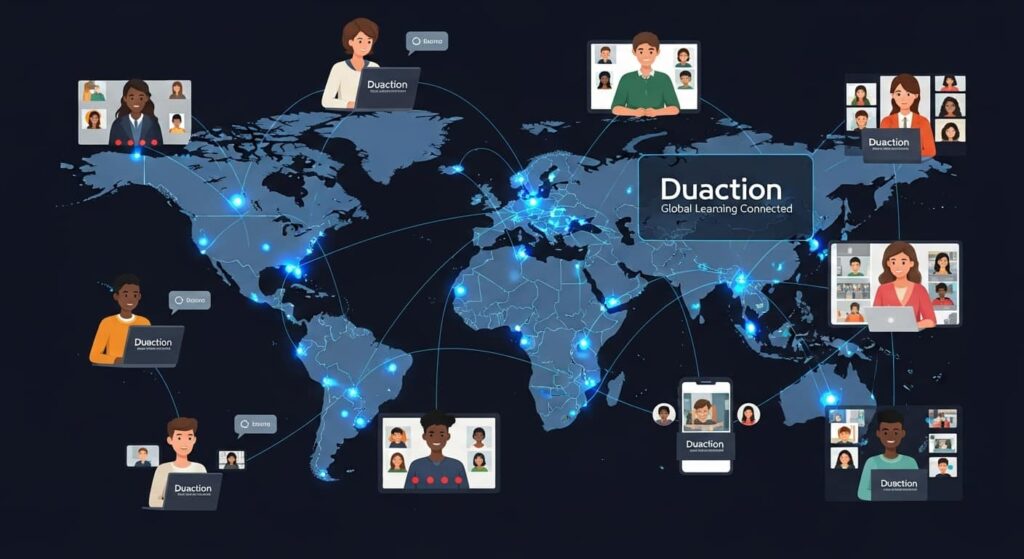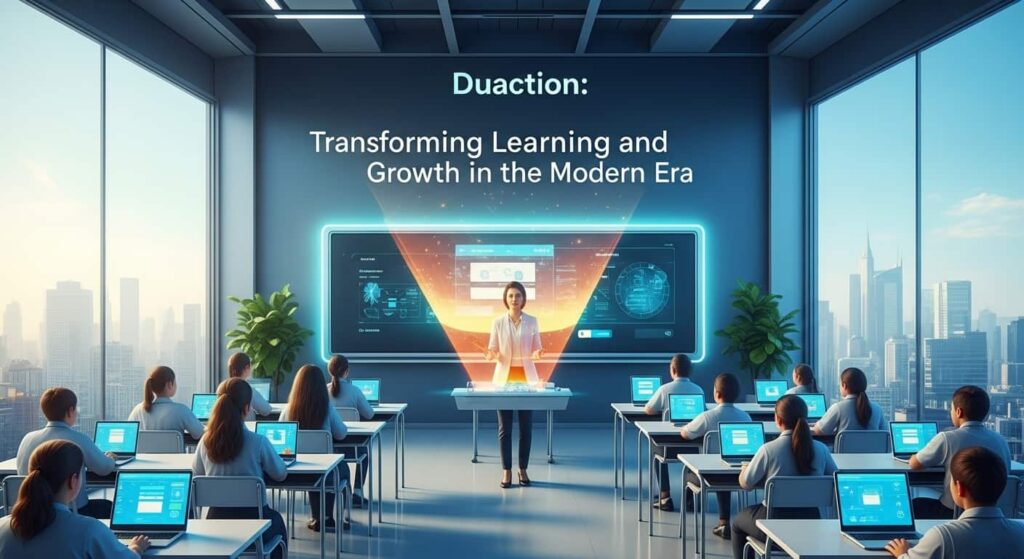Introduction
Education has always been the backbone of human progress, shaping individuals, communities, and nations. But in today’s rapidly evolving world, traditional learning models are no longer enough to meet the demands of modern society. Enter Duaction—a forward-thinking approach to education that blends learning and growth in new, dynamic ways.
Duaction isn’t just about classrooms or textbooks. It represents a shift toward interactive, personalized, and technology-driven education that prepares individuals for both personal success and professional excellence. In this article, we will explore how Duaction is transforming learning in the modern era, its benefits, challenges, and its role in shaping the future of global development.
The Meaning of Duaction in Modern Learning

Duaction is more than a buzzword; it signifies a dual action—learning and applying knowledge simultaneously. Unlike traditional education models, which often separate theory from practice, Duaction encourages real-time application of skills in real-life contexts.
For example:
- Instead of only reading about digital marketing strategies, a student under Duaction might be tasked with creating and managing a live campaign.
- A medical student may learn about diagnosis in the classroom but also engage in simulations and hands-on practices at the same time.
This fusion of learning and doing bridges the gap between knowledge and practical application, ensuring that learners don’t just accumulate information but also know how to use it effectively.
Why Duaction Matters in the Modern Era
The modern world is fast-paced, technology-driven, and interconnected. Employers today don’t just look for degrees; they look for problem solvers, innovators, and adaptable individuals. This is where Duaction makes a difference.
Some key reasons why Duaction is vital include:
- Bridging Skill Gaps: Traditional education often leaves graduates unprepared for real-world challenges. Duaction provides direct exposure to those challenges during the learning phase.
- Encouraging Lifelong Learning: With industries changing rapidly, professionals need to constantly upskill. Duaction fosters continuous growth and adaptability.
- Boosting Confidence: Learners gain confidence by applying knowledge immediately rather than waiting until after graduation.
- Enhancing Employability: Graduates with Duaction experiences stand out in the job market because they possess both knowledge and practical expertise.
The Evolution of Duaction
Duaction didn’t emerge overnight. It evolved as a response to the shortcomings of traditional education systems.
- Early Stages: Historically, education was about memorization and recitation. Application was often ignored.
- Industrial Revolution: The need for skilled workers shifted education toward vocational training.
- Digital Era: With the internet and AI reshaping industries, Duaction became more relevant, emphasizing blended learning—online platforms, project-based tasks, and real-world experiences.
Today, Duaction is gaining recognition globally as institutions, governments, and businesses collaborate to create more practical and outcome-oriented learning ecosystems.
Key Features of Duaction

To better understand how Duaction transforms learning, let’s look at its defining features:
1. Blended Learning Models
Duaction combines classroom instruction with digital platforms, interactive modules, and real-world projects. This ensures learning is flexible, accessible, and practical.
2. Real-Time Application
Students are encouraged to apply theories immediately, whether through internships, simulations, or entrepreneurial ventures.
3. Technology Integration
Artificial intelligence, virtual reality, and online platforms are integral to Duaction. They create immersive experiences that bring lessons to life.
4. Personalized Learning Paths
No two learners are alike. Duaction tailors experiences based on individual strengths, weaknesses, and goals, ensuring effective growth.
5. Collaborative Learning
Team-based projects and discussions form the backbone of Duaction, promoting critical thinking, creativity, and communication skills.
Duaction vs. Traditional Education
To highlight Duaction’s transformative impact, it’s helpful to compare it with conventional education systems.
| Aspect | Traditional Education | Duaction |
| Focus | Memorization and exams | Knowledge plus real-world application |
| Method | Teacher-centered | Student-centered |
| Assessment | Grades and tests | Projects, skills, and real outcomes |
| Flexibility | Rigid curriculum | Adaptive and personalized learning |
| Outcome | Theoretical knowledge | Practical expertise and confidence |
This comparison shows how Duaction addresses the limitations of outdated models, making it more relevant in today’s interconnected and competitive environment.
The Role of Technology in Duaction
Technology is the driving force behind Duaction’s success. Without it, real-time, flexible, and personalized learning wouldn’t be possible.
- Artificial Intelligence (AI): Helps design personalized learning plans, analyze student performance, and provide instant feedback.
- Virtual Reality (VR): Immerses learners in simulated environments, perfect for medical, engineering, or architectural training.
- Online Platforms: Tools like Google Classroom, Zoom, or specialized learning management systems make global collaboration and flexible study possible.
- Gamification: Turning learning into interactive challenges keeps learners motivated and engaged.
By embracing these technologies, Duaction ensures students are not only educated but also technologically equipped for the future.
The Global Impact of Duaction

Duaction is not limited to one region or country; its influence is spreading worldwide.
- United States: Universities are increasingly adopting project-based curricula alongside traditional lectures.
- Europe: Countries like Germany and Finland emphasize practical training alongside classroom education, aligning with Duaction principles.
- Asia: In nations such as Japan and South Korea, technology-driven learning has been a game-changer.
- Developing Nations: Duaction is helping bridge the education gap by providing affordable, technology-based learning opportunities.
A UNESCO report indicates that by 2030, nearly 50% of jobs worldwide will require advanced digital and practical skills. Duaction is one way to ensure learners are prepared for this transformation.
Benefits of Duaction
The advantages of Duaction are extensive and long-lasting:
For Students
- Builds practical skills alongside theoretical knowledge.
- Encourages creativity, problem-solving, and innovation.
- Provides exposure to industry-level challenges before graduation.
For Educators
- Enables teachers to track progress in real-time through data-driven tools.
- Fosters more engaging and interactive teaching methods.
For Employers
- Produces job-ready graduates with both soft and hard skills.
- Reduces the cost of additional training programs.
For Society
- Encourages innovation and entrepreneurship.
- Prepares a workforce capable of addressing global challenges.
Challenges in Implementing Duaction
Despite its promise, Duaction faces certain obstacles:
- High Costs: Technology and infrastructure investments can be expensive.
- Resistance to Change: Some institutions and educators are hesitant to move away from traditional models.
- Digital Divide: Not all students have equal access to devices and the internet.
- Curriculum Development: Designing a curriculum that balances theory and practice requires expertise and resources.
These challenges, however, are not insurmountable. With collaboration between governments, institutions, and private sectors, Duaction can become more widely accessible.
Duaction and the Future of Work

Workplaces of the future will demand adaptability, creativity, and digital fluency. Duaction aligns perfectly with these demands.
- Remote Work: By familiarizing learners with digital tools, Duaction prepares them for remote and hybrid jobs.
- Entrepreneurship: Students learn not only how to follow instructions but also how to innovate and lead.
- Global Collaboration: By using online platforms, learners are prepared for cross-cultural and global teamwork.
A World Economic Forum study predicts that 65% of children entering primary school today will work in jobs that don’t yet exist. With Duaction, students gain transferable skills that remain relevant no matter how industries change.
Real-Life Examples of Duaction in Action
- Coding Bootcamps: Instead of just teaching theory, they immerse learners in building real applications.
- Medical Training: Simulations allow students to practice surgeries and diagnoses in safe, virtual environments.
- Business Schools: Students often run live case studies with real companies, solving actual business problems.
These examples highlight how Duaction bridges the gap between education and real-world application, ensuring learners are fully prepared for challenges ahead.
The Future of Duaction
Looking ahead, Duaction is set to become the foundation of education systems worldwide. Some possible directions include:
- Greater integration of AI and machine learning for highly personalized experiences.
- Expansion of global collaborative platforms, connecting students from different cultures.
- Adoption in public education systems, ensuring equal opportunities for all.
- Focus on sustainability education, preparing learners to tackle global issues like climate change.
Duaction’s role will expand beyond classrooms, influencing corporate training, lifelong learning, and even community development programs.
Conclusion
Duaction is more than an educational model; it’s a revolution in how we learn, grow, and prepare for the future. By combining theoretical knowledge with practical application, it creates well-rounded individuals ready to take on the challenges of the modern world.
In an era where information is abundant but skills are scarce, Duaction bridges the gap by fostering adaptability, innovation, and resilience. Its benefits extend beyond students to educators, employers, and society at large, making it a powerful force in shaping the future of education and work.
As technology continues to evolve and the demands of global industries change, Duaction will remain a cornerstone of progress—transforming not only how we learn but also how we live and contribute to a better world.
